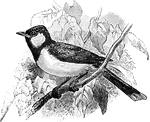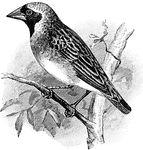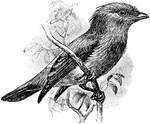Clipart tagged: ‘songbirds’
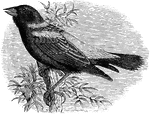
Bobolink
"Dolichonyx oryzivorus. Bobolink. Meadow-wink. Skunk Blackbird (Northern States), Reed-bird (Middle…

Snow Bunting
"Plectrophanes nivalis. Snow Bunting. Snowflake. Pure white; the bill, feet, middle of back, scapulars,…

Yellow-breasted Chat
"Yellow-breasted Chat or Icteria virens. Bright olive-green, below golden-yellow, belly abruptly white;…

Black-capped Chickadee
"Crown and nape, with chin and throat, black, separated by white sides of the head. Upper parts brownish-ash,…
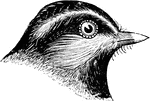
Mountain Chickadee
"Upper part ashy-gray, with scarcely a shade, and only on the rump, under parts similarly grayish-white,…
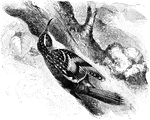
Common Brown Creeper
"Common Brown Creeper. Upper parts dark brown, changing to rusty-brown on the rump, everywhere streaked…

Swallow-tailed Flycatcher
"Milvulus forficatus. Swallow-tailed Flycatcher. Scissor-tail. Crown patch orange or scarlet. General…

Black-capped Gnat-catcher
"- a, head of a (Polioptila nigriceps) Black-capped Gnat-catcher. b, head of a(Polioptila caerulea)…
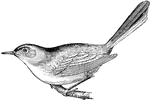
Blue-gray Gnat-catcher
"Grayish-blue, bluer on the crown, hoary on the rump, the forehead black, continuous with a black superciliary…

Arkansaw Goldfinch
"Astragalinus psaltria. Arkansaw Goldfinch. Upper parts uniform olive-green, without any black; below…

Black-headed Song Grosbeak
"Zamelodia melanocephala. Black-headed Song Grosbeak. Adult male with the crown, sides of head, back,…
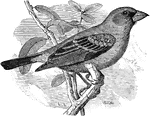
Blue Grosbeak
"Guiraca caerulea. Blue Grosbeak. Adult male: Rich dark blue, nearly uniform, but darker or blackish…

Cardinal Grosbeak
"Cardinalis virginianus. Cardinal Grosbeak. Cardinal Red-bird. Virginia Nightinggale. male, adult: Rich…
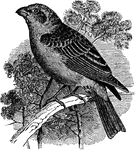
Pine Grosbeak
"Pinicola enucleator. Pine Grosbeak. Light carmine or rosy-red, feathers of back with dusky centres;…
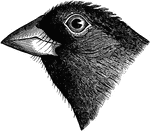
Blue Grosbeak Bill
"Guiraca. Blue Grosbeak. Bill Commissure strongly angulated far beyond base, with deep under mandible…
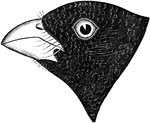
Song Grosbeak Bill
"Zamelodia. Song Grosbeak. Bill extremely heavy, with the lower mandible as deep as the upper or deeper,…

Canada Jay
"Perisoreus canadensis. Canada Jay. Whiskey Jack. Moose-bird. Gray whitening on head, neck, and breast;…
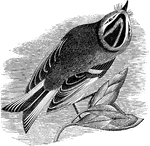
Golden Crested Kinglet
"Upper parts olive-green, more or less bright, sometimes rather olive-ashy, always brightest on the…
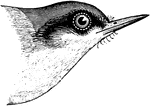
Brown-headed Nuthatch
"No black cap or white stripe on head. Upper parts dull ashy-blue; under parts sordid or muddy whitish.…
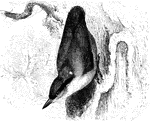
European Nuthatch
"Crown clear hair-brown; a white spot on nape; middle tail-feathers plain." Elliot Coues, 1884.

Red-breasted Nuthatch
"Upper parts leaden-blue the central tail-feathers the same; wings fuscous, with slight ashy edgings…
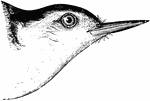
White-Breasted Nuthatch
"Upper parts, central tail-feathers, and much edging of the wings, clear ashy-blue; whole crown, nape,…

Baltimore Oriole
"Icterus galbula. Baltimore Oriole. Golden Robin. Firebird. Hangnest. Adult male: Black and orange.…
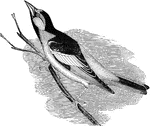
Bullock's Oriole
"Icterus bullocki. Bullock's Oriole. Adult male: Similarly black and orange, the orange invading the…

Ovenbird
"Golden-crowned Wagtail Warbler. Golden-crowned Accentor. Golden-crowned Thrush. Oven-bird. Seiurus…
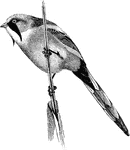
Reed Pheasant
"Panurus biarmicus, the "Bearded Tit" or "Reed-Pheasant" plumage is orange-brown above, with grey crown…

Song Sparrow
"Melospiza fasciata. Song Sparrow. Silver-tongue. Below, white, slightly shaded with brownish on the…
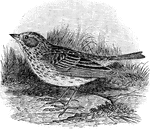
Common Savanna Sparrow
"Passercules s. savana. Common Savanna Sparrow. Thickly streaked everywhere above, on sides, and across…
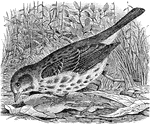
Fox Sparrow
"Passerella iliaca. Eastern Fox Sparrow. General color above ferrugineous or rusty-red, purest and brightest…
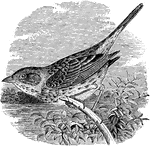
Lincoln's Sparrow
"Melospiza lincolni. Lincoln's Song Sparrow. Below, white, with a broad brownish-yellow belt across…

Swamp Sparrow
"Melospiza palustris. Swamp Song Sparrow. Crown bright chestnut, blackening on forehead, the red cap…

Yellow-winged Sparrow
"Coturniculus passerinus. Yellow-winged Sparrow. Quail Sparrow. Grasshopper Sparrow. Edge of wing conspicuously…

White-belied Swallow
"Entire upper parts glossy dark green; wings and tail blackish, lustrous; lores black. Entire under…
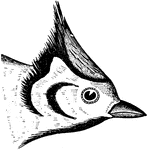
Bridled Titmouse
"Upper parts olivaceous-ash, wings and tail darker, edged with the color of the back, or even a brighter…
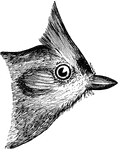
Tufted Titmouse
"Entire upper parts ashy, the back usually with a slight olivaceous shade, the wings and tail rather…
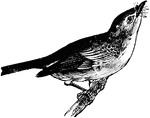
Warbling Vireo
"Similar to V. gilvus, but smaller; colors paler; bill more depressed; upper mandible almost black;…

Black-throated Gray Warbler
"Black-throated Gray Warbler or Dendroica nigrescens. Above, bluish-ash, the interscapular region, and…

Canada Warbler
"Myiodioctes canadensis. Canadian Fly-catching Warbler. Canada Warbler. Bluish-ash; crown speckled with…
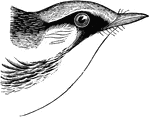
Chestnut-sided Warbler
"Chestnut-sided Warbler, Dendroica pensylvanica. Back streaked with black and pale yellow (sometimes…
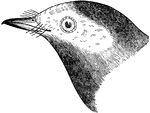
Hooded Warbler
"Myiodioctes mitratus. Hooded Fly-catching Warbler. Hooded Warbler. Clear yellow-olive above; below,…
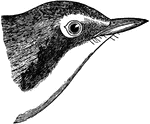
Kentucky Warbler
"Kentucky Warbler. Oporornis formosus. Clear olive-green; entire under parts bright yellow, olive-shaded…

Magnolia Warbler
"Black -and-Yellow Warbler. Magnolia Warbler. Back black, usually quite pure and uninterrupted in the…
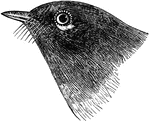
Painted Fly-catching Warbler
"Painted Fly-catching Warbler. Setophaga picta. Painted Redstart. Lustrous black; middle of breast and…
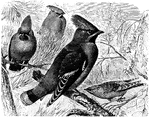
Bohemian Waxwing
"Ampelis garrulus. Bohemian Waxwing. General color brownish-ash, shading insensibly from the clear ash…
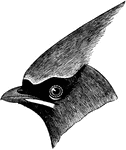
Cedar Waxwing
"Ampelis cedrorum. Cedar Waxwing. Carolina Waxwing. Cedar-bird. Cherry Bird. General color shading from…

Long-billed Marsh Wren
"Long-billed Marsh Wren. T. palustris. Above clear brown, unbarred, the middle of the back with a large…

Rock Wren
"Upper parts pale brownish-gray, minutely dotted with blackish and whitish points together, and usually…
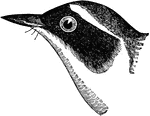
Common Yellowthroat
"Geothlypis trichas. Common Yellowthroat. Yellow-throated Ground Warbler. Maryland Yellow-throat. Upper…
